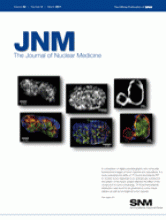TO THE EDITOR: We read with interest the review by Ichise and Harris (1), who proposed 11C-dihydrotetrabenazine (11C-DTBZ) PET as a potentially useful method for imaging β-cells in the native pancreas. 11C-DTBZ targets the vesicular monoamine transporter type 2, which is expressed by β-cells but is absent from the exocrine pancreas. Although the authors have discussed several limitations of this method, they have not addressed the one that is perhaps most important and precludes the use of 11C-DTBZ PET for imaging β-cells in the native pancreas. β-cells represent only 1%–2% of pancreatic volume and are clustered in islets of Langerhans throughout the pancreas. Islets are very small (∼50–400 μm in diameter (2))—a problem that cannot be resolved by current noninvasive in vivo imaging methods, including PET. Equally important, the islets and pancreas of patients with diabetes are atrophic, compared with those of healthy controls (2). The combination of the relatively low spatial resolution of PET and islet/pancreas atrophy in diabetes will result in underestimation of the true concentration of a certain compound (in this case 11C-DTBZ), if not corrected for partial-volume effects (3,4). In fact, if one corrects for partial-volume effects, there will be no differences in degree of uptake of a certain β-cell–specific tracer between patients (with a substantial degree of atrophy) and controls.
Sweet et al. (5) reported that the low-volume fraction of β-cells within the exocrine pancreas (about 1:100) requires that β-cells retain labeled imaging agents at least 1,000-fold more strongly than exocrine cells, in order for β-cell imaging in the pancreas to succeed by quantitative techniques. However, this level of retention is almost impossible and is not achievable with any existing agents. In addition, the high concentration of such compounds will result in significant radiation toxicity to the β-cells. Therefore, we believe it is ill conceived that β-cell imaging in the native pancreas be considered feasible with the technologies available today. However, the contrary is true for imaging the fate of transplanted pancreatic islets. Particularly, subcutaneous islet transplants may be reasonable, quantifiable targets for PET. The advantage of transplanting islets subcutaneously is that this site suffers considerably less from accumulation and uptake of certain compounds in non–β-cells than do other organs or structures, such as the liver and kidneys. The high concentration of β-cells at a known location and the opportunity to perform partial-volume correction of acquired PET data (3,4) make it possible to calculate the exact standardized uptake value at this site.
Besides radiolabeled DTBZ, which was discussed by Ichise and Harris (1), other promising PET radiotracers for β-cell imaging, including 18F-l-dihydroxyphenaline (6) and sulfonylurea receptor ligands (7), deserve further investigation. We foresee an important role for 18F-FDG in the evaluation of islet transplants, complementary to β-cell–specific tracers (8). 18F-FDG may be used as a tracer to image immune activation associated with the rejection of islet grafts in the subcutaneous space (8). Early detection of subcutaneous islet cell rejection by increased trapping of 18F-FDG and decreased trapping of β-cell–specific tracers (which are taken up only by functioning islets) leads to a window for potential intervention before frank biochemical failure and rescue of the subcutaneous islet graft.
We hope that this communication will eliminate some important misconceptions about β-cell imaging and stimulate meaningful investigations in this increasingly important field.
- © 2011 by Society of Nuclear Medicine







